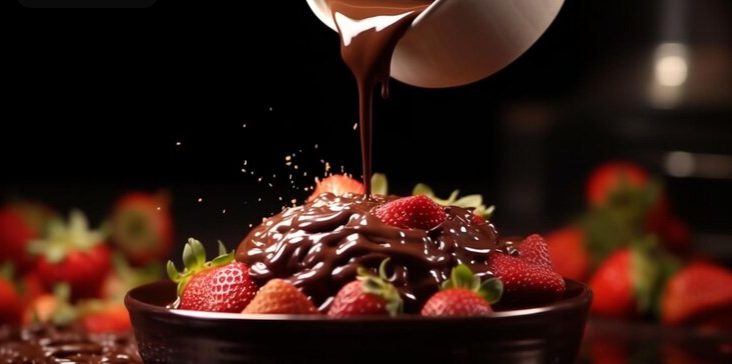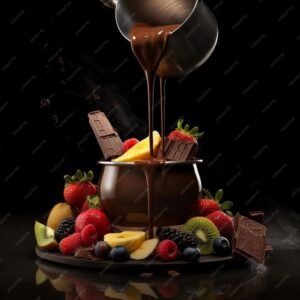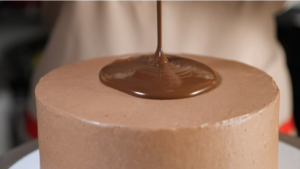What are the four types of fondue? Fondue, originating from Switzerland, is a communal dish where participants dip bread, fruits, or meats into a shared pot of melted cheese, chocolate, oil, or broth. This interactive eating style is celebrated for its simplicity and sociability.
Significance and Popularity
A symbol of Swiss tradition, fondue has gained worldwide popularity, especially for gatherings in colder seasons. Its allure stems from both the communal dining experience and the rich, comforting tastes it offers.
Objective of the Article
The article will delve into the four primary types of fondue—cheese, chocolate, oil or broth, and dessert fondues. We’ll explore the ingredients, traditions, and modern adaptations of each type, offering insights and tips for enjoying and hosting fondue experiences.
The Four Main Types of Fondue
Cheese Fondue
- Description and Ingredients A mix of melted cheeses like Gruyère and Emmental, flavored with white wine, garlic, and cornstarch to maintain smoothness.
- Popular Variants
- Swiss Fondue: Traditional with kirsch and nutmeg.
- French Fondue (Fondue Savoyarde): Uses Comté and Beaufort, sometimes blue cheese.
- Italian Fondue (Fonduta): Made with Fontina, eggs, and truffles for richness.
Chocolate Fondue
- Description and Common Dippers Melted chocolate served with fruits, cakes, and marshmallows. Varieties include dark, milk, or white chocolate, often enhanced with cream or butter.
- Cultural Popularity Known for its simplicity and elegance, favored in romantic settings and festive gatherings.
Oil or Broth Fondue (Fondue Bourguignonne)
- Description and Types of Meats Used Guests cook meat or vegetables in hot oil or flavorful broth. Commonly used meats include beef and shrimp.
- Safety and Preparation Tips Use stable pots and keep the temperature controlled. Employ meat-specific forks to prevent cross-contamination.
Dessert Fondues (Other than Chocolate)
- Common Ingredients and Variations Involves caramel, butterscotch, or marshmallow, sometimes enhanced with liqueurs or spices.
- Pairings and Occasions Ideal for festive or family occasions, paired with light wines or dessert cocktails for a fun, customizable dessert experience.
Historical Context and Evolution
Origins of Fondue
Fondue originated in the Swiss Alps, primarily as a way to utilize aged cheeses and breads during the winter months when fresh food was scarce. The earliest known recipe for cheese fondue appears in a 1699 book published in Zurich, which described melting cheese with wine. It was a practical dish, created out of necessity to feed families with limited resources during harsh winters.
Evolution Into Various Types
What are the four types of fondue ?As fondue’s popularity spread, it evolved beyond its humble beginnings. By the mid-20th century, fondue had become a symbol of Swiss culture and culinary finesse, celebrated not just in Switzerland but globally. The introduction of chocolate fondue in the 1960s, popularized by chef Konrad Egli in New York, marked a significant expansion in fondue types, including oil and broth fondues for cooking meats and vegetables, and even dessert fondues involving caramel and butterscotch. This diversification mirrored global culinary trends and the increasing international exchange of cultural practices.
Cultural Significance Across Different Regions
In Switzerland, fondue remains a cherished traditional dish, often enjoyed in communal settings, symbolizing warmth and shared experiences. In France and Italy, fondue has been adapted to local tastes and ingredients, strengthening its place in European gourmet cuisine. Elsewhere, fondue has been embraced as a festive and social meal, popular at gatherings and special occasions. Its adaptability and the social aspect of dipping and sharing have allowed fondue to maintain its relevance and popularity across different cultures, continually adapting to new tastes and dining traditions.
What are the four types of fondue?
Cheese Fondue
- Ingredients and Cooking Techniques Start with high-quality cheeses such as Gruyère and Emmental. Grate the cheese and toss it with a little cornstarch to prevent clumping. Heat white wine in the fondue pot, then gradually add the cheese mixture, stirring constantly until smooth and creamy. A splash of kirsch and a pinch of nutmeg can enhance the flavor.
- Serving Etiquette and Equipment Serve cheese fondue with cubed bread, vegetables, and small pickles. Use a ceramic or enameled cast iron pot to maintain an even heat. Each guest should have a fondue fork for dipping.
Chocolate Fondue
- Ingredients and Cooking Techniques Melt good quality chocolate with a bit of cream in a fondue pot over low heat, stirring until smooth. Variations can include different types of chocolate or additions like cinnamon or vanilla for flavor.
- Serving Etiquette and Equipment Offer guests a variety of dip-ables such as strawberries, banana slices, marshmallows, and pound cake. Use a ceramic pot to prevent the chocolate from burning. Fondue forks or skewers are used for dipping.
Oil or Broth Fondue (Fondue Bourguignonne)
- Ingredients and Cooking Techniques For oil fondue, use a neutral oil with a high smoke point, heated to 350-375°F. For broth fondue, prepare a flavorful stock and heat it in the pot. Meat or vegetables are cut into bite-sized pieces for cooking.
- Serving Etiquette and Equipment Use a metal fondue pot for oil or broth fondues because of the higher temperatures involved. Provide guests with safety tips, such as keeping the fondue fork handles clear of the hot oil. Serve with various dipping sauces on the side.
Dessert Fondues (Other than Chocolate)
- Ingredients and Cooking Techniques Caramel fondue involves melting caramels with a bit of cream or milk to achieve a smooth consistency. Butterscotch fondue is similar, using butterscotch chips and cream. Both can be flavored with a dash of sea salt or vanilla extract.
- Serving Etiquette and Equipment Serve with fruits like apples and pears, and sweets like cookies or pretzels. A ceramic pot works best for maintaining the temperature without burning the fondue. Use fondue forks or bamboo skewers for dipping.
Tips for Hosting a Fondue Party
- Planning and Organization Choose a variety of fondues to cater to different tastes. Prepare and chop all ingredients beforehand to ensure smooth operation during the party.
- Setting the Scene Arrange the fondue pots centrally on the table so all guests can reach them easily. Provide each guest with a personal set of dipping forks marked with different colors for identification.
- Safety and Enjoyment Ensure that the dining area is well-ventilated if using fuel burners. Keep a careful eye on the temperature of oils and broths to prevent overheating. Encourage guests to mingle and share different fondue pots to enhance the communal and festive atmosphere of the meal.
Common Mistakes and Troubleshooting
Avoiding and Fixing Common Fondue Pitfalls
Common issues with fondue include cheese or chocolate that clumps or oils that overheat. To avoid these, always use a low, steady heat and stir consistently. For cheese fondue, adding a little lemon juice or vinegar can help stabilize the emulsion and prevent separation. If the fondue does begin to clump or separate, adding a small amount of warm liquid and stirring vigorously usually restores the smooth texture.
Adjusting Consistency and Flavor
If fondue is too thick, gradually add warm wine, broth, or cream until the desired consistency is reached. For overly thin fondue, a slurry of cornstarch and cold water can be mixed in slowly to thicken it. Adjust flavors by adding spices, seasonings, or additional primary ingredients like cheese or chocolate, tasting as you go to achieve the perfect balance.
Frequently Asked Questions About Fondue
What is the best cheese for cheese fondue?
The best cheeses for fondue are those that melt well and have a robust flavor. Traditional choices include Swiss cheeses like Gruyère and Emmental. For a richer flavor, you can also mix in a bit of sharp cheddar or Fontina.
Can fondue be made without alcohol?
Yes, fondue can be made without alcohol. For cheese fondue, you can substitute white wine with lemon juice or non-alcoholic wine. For chocolate fondue, simply omit the alcohol and use cream or milk to achieve the desired consistency.
How do you keep fondue from separating?
To prevent fondue from separating, maintain a consistent low heat and stir frequently. Using a stabilizer like cornstarch mixed with the cheese or chocolate can also help maintain the emulsion. If separation occurs, adding a small amount of lemon juice or wine can help re-emulsify the mixture.
What are the best dippers for chocolate fondue?
Great dippers for chocolate fondue include fresh fruits such as strawberries, bananas, and apple slices, as well as marshmallows, pound cake, and biscotti. For a twist, try salty snacks like pretzels which complement the sweet chocolate.
Is fondue only a winter dish?
While fondue is popular in the winter due to its warming qualities, it can be enjoyed year-round. The key is in adapting the dippers and fondue types to suit the season, such as lighter broths and fresh vegetables in the summer.
Pairings and Recommendations
Pairings for Each Type of Fondue
- Cheese Fondue Pairings
- Wine: A crisp white wine, such as Sauvignon Blanc or a light Swiss wine, pairs beautifully with the richness of cheese fondue.
- Accompaniments: Offer a variety of dippables such as crusty bread, boiled potatoes, gherkins, and pickled onions to complement the cheese.
- Chocolate Fondue Pairings
- Beverages: Pair with dessert wines, coffee, or even a simple hot chocolate to enhance the chocolate flavors.
- Dippers: Fresh fruits like strawberries and bananas, marshmallows, pound cake, and biscotti make excellent dippers.
- Oil or Broth Fondue Pairings
- Sauces: Provide a range of dipping sauces such as béarnaise, tartar, and cocktail sauces to enrich the flavor of cooked meats and vegetables.
- Sides: A side of seasoned rice or a fresh salad balances the richness of the fondue.
- Dessert Fondue (Non-Chocolate) Pairings
- Beverages: Light and sweet sparkling wines or fruit-infused water pair well with sweet fondues.
- Dippers: Offer an assortment of dippers like apple slices, pear chunks, pretzels, and vanilla wafers.
Recommendations for Hosting the Perfect Fondue Evening
- Setting the Atmosphere: Create a cozy and inviting atmosphere with soft lighting and comfortable seating to encourage guests to relax and enjoy the experience.
- Variety and Choice: Include a variety of fondue types if possible, allowing guests to choose from cheese, chocolate, oil, or broth fondues. This variety caters to different preferences and makes the meal more interactive and fun.
- Interactive Elements: Consider adding fun elements like fondue game rules or themed decorations based on the type of fondue being served.
Fondue Etiquette and Social Tips
Fondue Etiquette
- Dipping Rules
- Always use the fondue forks provided for dipping—never use personal cutlery.
- Avoid double-dipping. Once a piece of bread, fruit, or meat is dipped and bitten, it shouldn’t go back into the communal pot.
- Rotate turns for dipping to ensure everyone gets equal access without crowding the fondue pot.
- Handling Accidents
- If a piece of dipper falls into the fondue, it’s often seen as an opportunity for a playful penalty, like singing a song or telling a joke.
- Keep napkins handy to manage drips or spills, maintaining a clean and pleasant dining area.
Social Tips for Fondue Gatherings
- Conversation Starters
- Fondue parties are great for mingling. Encourage guests to share stories or discuss their favorite types of fondue and accompaniments.
- Use fondue as a centerpiece for themed parties, such as a ’70s Swiss ski lodge night or a chocolate lovers’ gathering.
- Group Size and Interaction
- Keep the guest list manageable; a fondue pot typically serves 4-6 people comfortably. If you have more guests, consider multiple pots to keep everyone involved.
- Arrange seating to foster interaction. Circular or square tables work best so everyone can reach the pot and engage with each other.
Recommended Internal Links
- Chocolate Fondue:
- Embed Link At: In the section discussing melting chocolate as part of the fondue experience, you can link to the chocolate fondue recipe.
- Internal Link: Chocolate Fondue Recipe
- Beer Cheese Fondue:
- Embed Link At: When you mention the variety of cheeses used in different types of fondue, including a mention of more unique fondue variations like beer cheese fondue could be insightful.
- Internal Link: Beer Cheese Fondue Recipe
Resources and Readings
- Alpenwild’s Overview of Fondue:
- Embed Link At: In the « Historical Context and Evolution » section, particularly when discussing the origins and traditional significance of fondue in Swiss culture.
- External Link: History and Tradition of Fondue at Alpenwild
- Wikipedia on Fondue:
- Embed Link At: In the introduction when you first mention fondue, to give readers a quick overview of what fondue is before diving into more detailed discussions.
- External Link: Fondue – Wikipedia
- Fondue’s History and Cultural Impact:
- Embed Link At: In the section that discusses the popularization of fondue and its cultural implications, particularly in how it was marketed in the 1930s.
- External Link: The Fascinating History & Swisstory of Fondue
- Culinary Curiosities: Fondue’s History:
- Embed Link At: Towards the end of the « Historical Context and Evolution » section to provide readers with additional perspectives on how fondue became a symbol of communal dining.
- External Link: What’s the History of Fondue? – Foodservice News
These links should offer your readers a broad and enriching context, deepening their understanding of fondue’s role both historically and culturally.
Conclusion
What are the four types of fondue? Fondue remains a cherished culinary tradition that brings people together around a communal pot, offering a unique and interactive dining experience. Whether it’s the creamy decadence of cheese, the rich allure of chocolate, or the savory delight of broth and oil fondues, this versatile dish caters to a variety of tastes and preferences. Beyond just being a meal, fondue embodies a spirit of sharing and celebration, making it perfect for any gathering. As you explore the diverse world of fondue, remember the tips and insights from this guide to enhance your fondue-making skills and ensure every fondue party is a success. Embrace the art of fondue and enjoy the warmth and connection it brings to your table.



